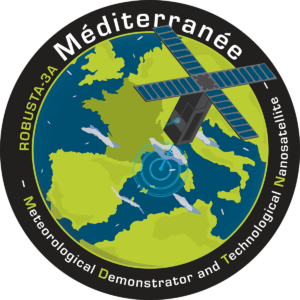A nanosatellite to detect the risk of a Cevenol episode
The aim of the " Mediterranean Project " is to improve forecasts of severe weather by collecting data where water vapour is formed, i.e. at sea. A new challenge proposed by the Montpellier University Space Center (CSUM) and supported by the Van Allen Foundation and its partners, including the UM, which should come to fruition in 2021 with the launch of the ROBUSTA-3A MEDITERRANEAN nanosatellite.

The people of Montpellier know all about Cevennes storms. They're the stuff of autumn folklore, if the human and material toll weren't so high each time. What is perhaps less well known is the origin of these sudden meteorological incidents. " The Cevennes or Mediterranean episode is a conflict of air masses between the warm, humid air in the lower layer coming from the sea and the cold air at altitude coming from the Cevennes," recalls Laurent Dusseau, Director of the Van Allen Foundation and the CSUM.
Measuring water vapour at sea
Today, it's easy to measure these humidity fields thanks to GNSS signals, otherwise known as satellite positioning systems. In simple terms, this is a system based on a constellation of small satellites that enable us to find out the time of day or our 3D position via our cell phones, for example. " These signals will be modified by the presence of water in the atmosphere. We're going to use these variations to calculate the quantity of steam at a given location T", explains Laurent Dusseau. This technique is routinely used by Météo-France, and there are many observation points in France.
There are many observation points in France, but none at sea, and that's the originality and innovation of this project. " By detecting these warm air masses as soon as they form at sea, we can better anticipate the onset of Cevennes episodes. To make this possible, a partnership has been signed with the port of Sète to install sensors on board ships sailing in the Mediterranean. These devices emit signals that are picked up by the Robusta-3A Méditerranée nanosatellite, then relayed in near-real time to research teams at ENSTA Bretagne, IGN and Météo-France, other partners in the study. " For the information to remain valid, it must be transmitted live," insists Laurent Dusseau.
A 100% CSUM nanosatellite
Completely designed by the MUSC and financially supported by the Van Allen Foundation and the Centre national d'études spatiales(CNES) as part of the JANUS project, the Robusta-3A Méditerranée nanosatellite should be ready for launch at the end of 2021. This is the culmination of work begun in 2013, involving 140 students and a dozen apprentices and interns. The electronic subsystems were developed by the MUSC as part of pre-maturation projects supported by the Occitanie region. Robusta-3A will join the three other nanosatellites already launched by the MUSC.
For their part, the Institut national de l'information géographique et forestière(IGN) and the École nationale supérieure de techniques avancées(ENSTA) Bretagne, both CSUM partners, have been working on the quantity of data required to complete the scientific part of the mission. A thesis co-financed by the foundation and ENSTA will begin in December to continue work on methods for analyzing the data collected. Laurent Dusseau concludes: " With this project, we are perfectly in line with Muse's major themes. Better anticipation of severe meteorological phenomena will enable us to better protect populations.
The Van Allen Foundation
Created at the end of 2012, the main mission of the Van Allen Foundation, a partner of the UM, is to raise funds from philanthropy and make them available to the UM on behalf of the Montpellier University Space Center. It also promotes the UMSC's innovation and development projects through communication initiatives and ensures its governance.
A privileged partner of the University of Montpellier, the Van Allen Foundation has five founding members: the UM, Airbus defense and space, microelectronics supplier 3D Plus, engineering services designer Expleo and interconnection systems manufacturer Latécoère interconnection systems. Each of these companies finances the foundation to the tune of between 50,000 and 100,000 euros a year, and has a seat on the board of directors.
The Van Allen Foundation is a major player in collaboration between industry and academia in the space sector, where it promotes the transfer of technology and knowledge. It also funds practical training for young people in space-related professions. Since its creation in 2012, 180 student internships have been financed, with €2.75 million invested in Montpellier's university space center and its nanosatellite projects.